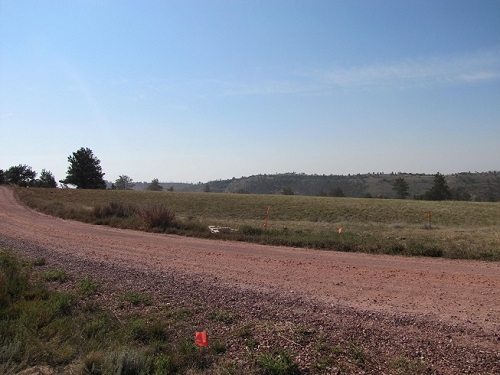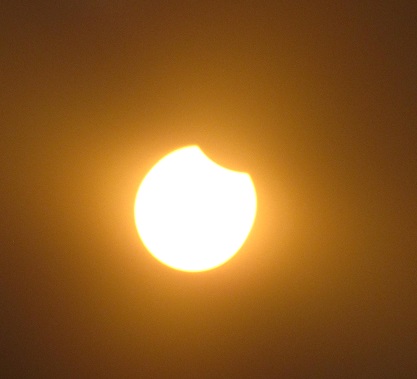By Richard Quinnell, editor-in-chief
Some millions of people in North America on Monday, August 21, positioned themselves, sometimes after hours of driving in stop-and-go traffic, along a narrow strip of land less than a hundred miles wide to catch a total eclipse of the sun. I was one of them. It was worth the effort.
My wife and I had been planning the trip for months. Although we live in Washington, we figured that Oregon would become too crowded and chose to go to Wyoming instead. Along the way, we would pick up my 95-year-old mother (she protests that she’s only 94.8) and head north from Denver to Wyoming’s Glendo State Park, located in the middle of totality’s path and, conveniently, just off of Interstate 25. But a last-minute assessment of the traffic predictions, and reported lack of available parking at Glendo, convinced us to branch off the Interstate and head to Guernsey State Park instead. Our hope was that, along this road less travelled, we would find a safe and comfortable place from which to view.
We scored. After a 6:00a.m. start and several hours of traffic, sometimes moving freely and sometimes stop-and-go, we arrived at the park’s entrance, where a well-prepared staff and volunteer group took our $6 parking fee and directed us to a wide area atop a ridge where parking had been marked out and portable toilets set up. They even offered us free eclipse glasses in case we had not come prepared. This was one of many such areas that the park had established, thus accommodating every car of the huge crowd that had descended on Guernsey that morning.

You could not have asked for a more perfect viewing site. We had vistas that stretched for dozens of miles in all directions, a cerulean sky with barely a hint of cloud, and a breeze to offset the heat of the day. As the event approached, we were joined by many others, most with families and some chatting about ditching work and the first day of school to be there. The party atmosphere began to grow.
As astronomers describe things, the eclipse started about 10:40a.m. local time. But to them, “start” meant that the disc of the moon first touches the disc of the sun. If you did not know that it was time to look, you would not notice anything different. There are no significant changes on the ground. Only by looking at the sun (through a solar filter, of course) would you see that a bite had been taken out of it.

But as the eclipse progressed, things changed. At some point, you notice that everything is dimmer, as if you had lightweight sunglasses on and could not take them off. The quality of shadows alters. You sense that something is happening, and if you didn’t know what it was, you might begin to get nervous.
Up to this point, witnessing a total eclipse is no different from witnessing a partial. Nearly everyone in the continental U.S. could see the partial eclipse, watching the day darken. But the difference between a partial and a total was about to be revealed. To paraphrase Mark Twain, it’s like the difference between the lightning bug and the lightning.
As the last of the sun was disappearing behind the moon, we could see an ominous darkness growing in the west. It was the moon’s shadow racing toward us, bringing a peculiar night to the summer’s morning. The color of the sky changed, and the scarlet and golden hues of sunset painted the horizon in all directions. This 360° sunset arrived in the company of a sudden chill. Temperatures dropped 10°+ as the fires that warm our planet became blocked.
In the final instants before the eclipse became total, all that can be seen of the sun is a white, glowing halo and a tiny flaring fragment just about to vanish. It was the famous “diamond ring” effect, when the last of the sun’s rays sneaks through a valley on the moon’s edge in its last grasp toward Earth.

The moment has arrived. Solar glasses come off and the awesome spectacle of a black hole in the sky surrounded by a white nimbus becomes visible to the naked eye. The crowd around us cheered; small children shrieked and danced with excitement. People pointed out the brightest stars that suddenly appeared (“There’s Venus, the morning star!”). I felt like I was suddenly in another world, or at least on the set of a science fiction movie. Others simply grew profoundly quiet, perhaps contemplating how truly small we were and how vast our universe is.

Totality in our location was scheduled to last about two-and-a-half minutes. It seemed much shorter than that. You scarcely have enough time to mentally adjust to the altered world around you when the process begins to reverse. Another diamond signals that it’s time to avert your eyes and replace your viewing glasses. The horizon lights with the colors of dawn. And the moment has passed. The denouement is a repeat of the build-up, backwards.
For scientists, the analysis of data collected during the eclipse will go on for years. The fact that totality’s path crossed an entire continent meant that a string of monitoring stations could collectively gather more than an hour of continuous observations during totality. For eclipse chasers, it was time to start planning for the 2020 Patagonia eclipse.
Throughout the hours needed to work through the return traffic, the few spectacular moments we had shared were all we could talk about. For my mother, it was the first total eclipse she had ever seen. It was the second for my wife and me, and yet a totally different experience. I can see now why there are folks who chase these eclipses all around the world. Each experience is profound and unique.
If you viewed the eclipse but were not in the path of totality, you missed a moment both profound and awe-inspiring. But there will be more chances. Eclipses occur every year or two somewhere in the world. The next total eclipse in the U.S., according to NASA, will be in 2024, crossing Texas and headed northeast. The key is that the path of totality is narrow, and you must be in the path to get the full effect. If at some time such a path is again within your reach, it’s worth making the effort to reach it.
For another perspective on the eclipse, check out Max Maxfield’s column.
Advertisement
Learn more about Electronic Products Magazine





